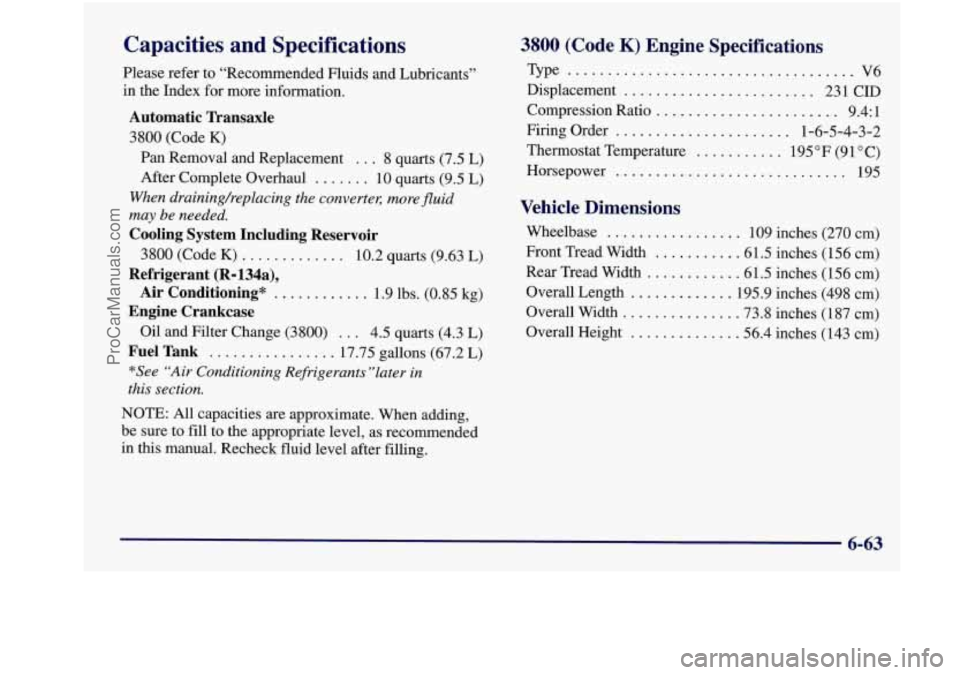fuel type OLDSMOBILE INTRIGUE 1998 Owners Manual
[x] Cancel search | Manufacturer: OLDSMOBILE, Model Year: 1998, Model line: INTRIGUE, Model: OLDSMOBILE INTRIGUE 1998Pages: 340, PDF Size: 17.93 MB
Page 232 of 340

If your vehicle is certified to meet California Emission
Standards (indicated on the underhood emission control
label),
it is designed to operate on fuels that meet
California specifications. If such fuels are not available
in states adopting California emissions standards, your
vehicle will operate satisfactorily on fuels meeting
federal specifications, but emission control system
performance may be affected.
The malfunction indicator
lamp on your instrument panel may turn on and/or your
vehicle may fail a smog-check test. If this occurs, return
to your authorized Oldsmobile retailer for diagnosis to
determine the cause of failure. In the event it
is
determined that the cause of the condition is the type of
fuels used, repairs may not be covered by your warranty.
Some gasolines that are not reformulated for low
emissions contain an octane-enhancing additive called
methylcyclopentadienyl manganese tricarbonyl (MMT);
ask your service station operator whether or not his fuel
contains MMT. General Motors does not recommend the
use of such gasolines. If fuels containing MMT are used,
spark plug life may be reduced and your emission
control system performance may be affected. The
malfunction indicator lamp on your instrument panel
may turn on. If this occurs, return to your authorized
Oldsmobile retailer for service.
To provide cleaner air, all gasolines in the United States
are now required to contain additives that will help
prevent deposits from forming in your engine and fuel
system, allowing your emission control system to
function properly. Therefore, you should not have to add
anything to the fuel. In addition, gasolines containing
oxygenates, such as ethers and ethanol, and
reformulated gasolines may be available in your area to help clean the air. General Motors recommends that you
use these gasolines if they comply with the
specifications described earlier.
NOTICE:
Your vehicle was not designed for fuel that
contains methanol. Don’t use it. It can corrode
metal parts in your fuel system and
also damage
plastic and rubber parts. That damage wouldn’t
be covered under your warranty.
6-4
ProCarManuals.com
Page 235 of 340

If you get gasoline on yourself and then
something ignites it, you could be badly burned.
Gasoline can spray out on you if you open the
fuel filler cap too quickly. This spray can happen
if your tank is nearly full, and is more likely in
hot weather. Open the fuel filler cap slowly and
wait for any “hiss” noise to stop. Then unscrew
the cap all the way.
Be careful not to spill gasoline. Clean gasoline from
painted surfaces as soon as possible. See “Cleaning the
Outside of Your Vehicle” in the Index. When
you put the cap back on, turn it to the right
(clockwise) until you hear a clicking sound. Make sure
you fully install the cap. The diagnostic system can
determine
if the fuel cap has been left off or improperly
installed. This would allow fuel to evaporate into the
atmosphere. See “Malfunction Indicator Lamp” in
the Index.
NOTICE:
If you need a new cap, be sure to get the right
type. Your retailer can get one for you.
If you get
the wrong type, it may not fit properly. This may
cause your malfunction indicator lamp to light
and your fuel tank and emissions system may be
damaged. See “Malfunction Indicator Lamp” in
the Index.
6-7
ProCarManuals.com
Page 268 of 340

Inflation -- Tire Pressure
The Tire-Loading Information label, which is located
inside the trunk lid, shows the correct inflation pressures
for your tires when they’re cold. “Cold” means your
vehicle has been sitting for at least three hours or driven
no more than 1 mile (1.6 km).
NOTICE:
Don’t let anyone tell you that underinflation or
overinflation is all right. It’s not. If your tires
don’t have enough air (underinflation), you can
get the following:
Too much flexing
0 Too much heat
Tire overloading
0 Bad wear
Bad handling
0 Bad fuel economy.
NOTICE: (Continued) NOTICE: (Continued)
If your tires have too much air (overinflation),
you can get the following:
Unusual wear
Bad handling
Rough ride
Needless damage from road hazards.
When to Check
Check your tires once a month
or more.
Don’t forget your compact spare tire.
It should be at
60 psi (420 Pa).
How to Check
Use a good quality pocket-type gage to check tire
pressure.
You can’t tell if your tires are properly inflated
simply by looking at them. Radial tires may look
properly inflated even when they’re underinflated.
Be sure to put the valve caps back on
the valve stems.
They help prevent leaks by keeping
out dirt and moisture.
6-40
ProCarManuals.com
Page 291 of 340

Capacities and Specifications
Please refer to “Recommended Fluids and Lubricants”
in the Index for more information.
Automatic Transaxle
3800 (Code K)
Pan Removal and Replacement ... 8 quarts (7.5 L)
After Complete Overhaul ....... 10 quarts (9.5 L)
When drainingheplacing the converter; more fluid
may be needed.
Cooling System Including Reservoir
3800 (Code K) ............. 10.2 quarts (9.63 L)
Refrigerant (R-l34a),
Air Conditioning*
............ 1.9 lbs. (0.85 kg)
Engine Crankcase
Oil and Filter Change (3800) ... 4.5 quarts (4.3 L)
Fuel Tank ................ 17.75 gallons (67.2 L)
*See “Air Conditioning Refrigerants ”later in
this section.
NOTE: All capacities are approximate. When adding,
be sure to fill to the appropriate level, as recommended
in
this manual. Recheck fluid level after filling.
3800 (Code K) Engine Specifications
Type .................................... V6
Displacement
........................ 231 CID
Compression Ratio
....................... 9.4: 1
Firing Order ...................... 1-6-5-4-3-2
Thermostat Temperature
........... 195°F (91°C)
Horsepower
............................. 195
Vehicle Dimensions
Wheelbase ................. 109 inches (270 cm)
Front Tread Width
.......... .6 1.5 inches (1 56 cm)
Rear Tread Width
........... .6 1.5 inches (156 cm)
Overall Length
............. 195.9 inches (498 cm)
Overall Width
.............. .73.8 inches (1 87 cm)
Overall Height
.............. 56.4 inches (143 cm)
6-63
ProCarManuals.com